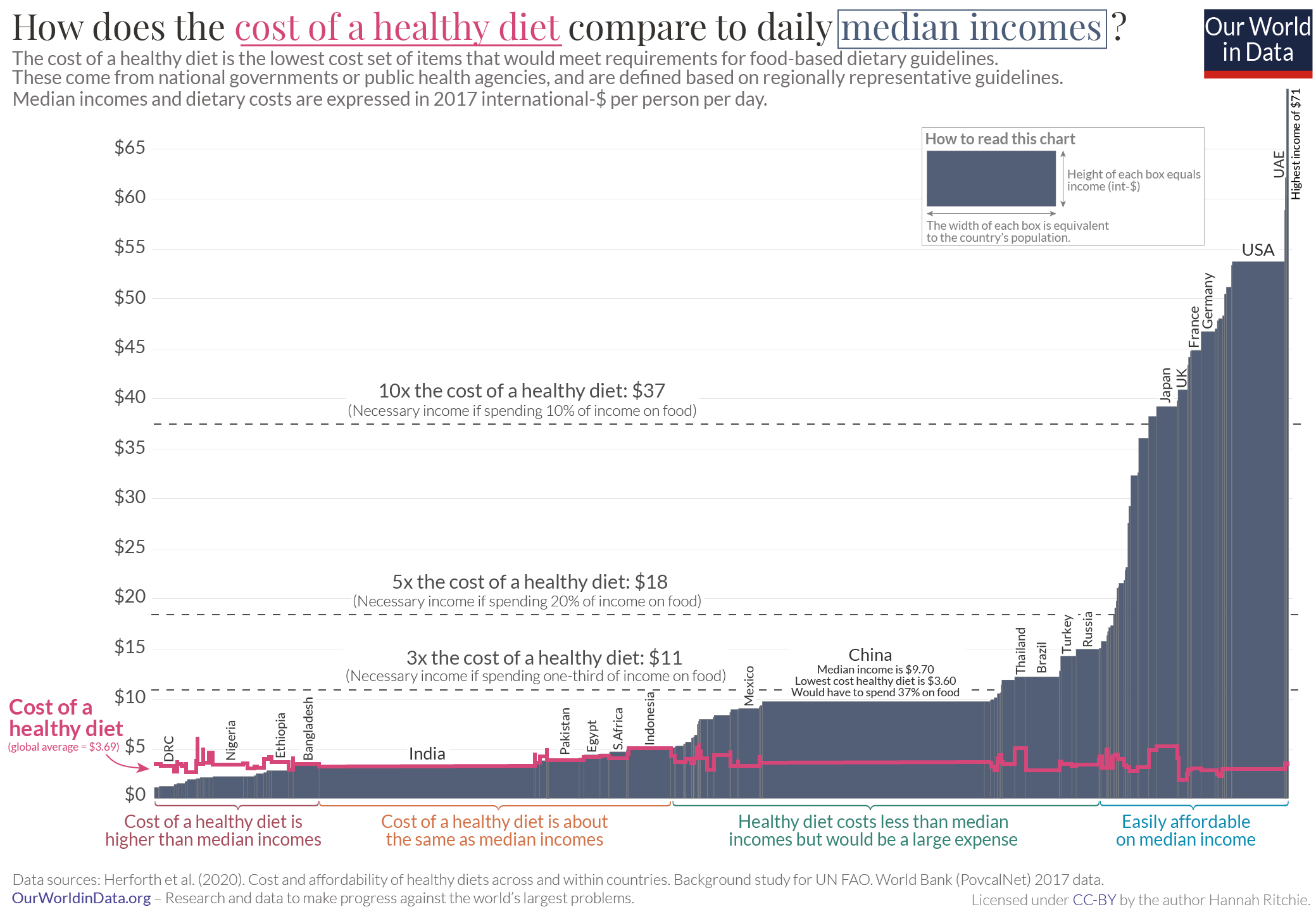Summary
A healthy diet is about much more than calories: we need a wide range of nutrient-dense foods to get all of the vitamins and minerals that are essential for good health. In this post I look at the costs of diets around the world. Healthy diets are expensive; more than four times the cost of a basic, calorie-sufficient one. This is true in every country in the world. As a result, three billion people cannot afford a healthy diet, even if they spend most of their income on food.
Being able to eat a healthy, nutritious diet is one of our most basic human needs. Yet billions of people go without; they suffer from ‘hidden hunger’, micronutrient deficiencies such as too little iron, calcium, vitamin-A or iodine.
There are many reasons why someone might not eat a nutritious diet.1 Often it’s because people cannot afford to.
To understand the affordability of food across the world a team of researchers looked at the lowest-cost options to meet basic nutritional requirements.2 As part of this study for the FAO’s The State of Food Security and Nutrition in the World report, Anna Herforth and colleagues asked the question: “what is the cheapest way to meet dietary requirements in each country?”.
They answered this question using data on prices for locally-available food items from the International Comparison Program (ICP) matched to other data on food composition and dietary requirements.
You find their full set of results in our Food Prices Data Explorer.
An energy sufficient diet: hundreds of millions cannot afford one
Let’s start with the most basic requirement: getting enough calories. These calories could come in any form, but the cheapest option in most countries is starchy foods and cereals. Living on this ‘energy sufficient’ diet would mean eating only maize flour or rice for every meal, a diet that is severely lacking all other important nutrients. When you look at people’s diets you see that in poor countries, people get most of their calories from starchy foods.
In each country, prices were measured at retail marketplaces specific to the local context – this could be anything from small open stalls to large supermarkets, whatever is most representative for the country.3 The total costs of diets are given in international-$.4
In the following text I always refer to international-$, but only use the $-sign to keep the text readable.
A person can eat an energy sufficient diet on less than $1 a day. The global average price for this diet across all countries in the study was $ 0.84 per day.
What does this mean for the affordability of a calorie sufficient diet? The researchers define ‘affordability’ by whether someone can afford it if they spend 63% of their income on food. The concept of ‘affordability’ is a somewhat subjective one, and will depend on an individual’s context. People at higher incomes spend a much smaller share on food. The relationship between our income and what we spend on food follows a fairly consistent pattern, known as Engel’s Law. Engel’s Law describes the empirical regularity that as incomes increase the share that we spend on food decreases (even if the total amount that we spend on food increases). We see this relationship holds true when we compare food expenditures across the world.
This means the poorest households spend a very high share of their income on food. The researchers chose this ‘63% threshold’ because this is the share that people at the lowest incomes do typically spend on food.
By comparing the cost of diets with income distributions across the world, researchers estimated that 275 million people could not afford the most basic energy sufficient diet in 2017.5 These are the very worst-off in terms of nutrition.
An important question is how subsistence farmers fit in. They are included in these numbers: the income measure used to calculate the affordability of diets does take the value of subsistence farming (i.e. home production) into account. When the FAO report states that these smallholder farmers cannot afford a calorie-sufficient diet, they’re really saying that they cannot produce one. This state – where farmers struggled to produce enough staple crops to feed their families – was the default position in the past. Most of the world population was undernourished. As a recent study on the history of global poverty estimates, just two centuries ago around three-quarters of the world “could not afford a tiny space to live, food that would not induce malnutrition, and some minimum heating capacity.”6
Today we might think of this calorie-sufficient threshold as the nutritional equivalent to the $1.90 international poverty line. It is the absolute bare minimum. It is a very low threshold that allows us to identify those living in the most dire of circumstances.
A healthy diet: three billion people cannot afford one
What people really need is a diverse and nutritious diet. Getting enough calories is important, but it is not sufficient to live a healthy and productive life. Eating only cereals and starchy foods will leave you deficient in protein, essential fats and the wide range of micronutrients that our bodies need to function optimally.
Most countries develop ‘food-based dietary guidelines’ which provide recommendations on what a ‘healthy diet’ would look like. This includes guidelines on what balance of foods across the many groups – cereals, fruits, vegetables, legumes, meat and dairy – is considered best for long-term health.
The researchers also looked at the lowest-cost options to meet these national food-based dietary guidelines. Of course, there is no universal ‘healthy diet’, particularly when we consider the strong cultural differences in what people eat. So, the researchers selected dietary guidelines which were regionally representative: this means we’re not expecting that people in India or Japan will adopt the national dietary guidelines of the United States, or vice versa.
Unsurprisingly, a diverse, healthy diet is much more expensive than a calorie-sufficient one. The researchers found that the average cost across the world was $3.69 per day. That’s more than four times higher.7
When we put these prices in the context of affordability – again defining this as spending 63% of our income on food – we find that three billion people cannot afford a healthy diet. In many of the world’s poorest countries – particularly across Sub-Saharan Africa – it’s unaffordable (or not producible) for most of the population. This is shown in the map which gives these figures as a percentage of the total population. In many countries, a healthy diet is out-of-reach for more than 90%.
How do incomes around the world compare with the price of a healthy diet?
A useful way to bring context to food prices is to compare the cost of a healthy diet with the median income of countries across the world.
Both of these distributions are shown in the chart. First I’ve plotted the income distribution of the world in blue – the height of each box corresponds to the median income of each country in 2017. The poorest countries you find on the left, the richest on the right. The width of each bar represents the size of the population in that country.
These are measured in international dollars, which correct for cross-country price differences.
On top of this income distribution I’ve added the cost of a healthy diet for each country – shown in pink.
In the poorest countries, the cost of a healthy diet is higher than the median income. Even if the average person in these countries spent all of their money on food, a healthy diet would be unaffordable.
In some countries – India is the largest among them – dietary costs would be roughly equal to the median income. There people would need to spend all of their income on food to afford a healthy diet.
Towards the right we find the world’s richest countries. There, median incomes are much higher than dietary costs. In these countries the median income earner can afford a healthy diet with a relatively small fraction of their income. The average person in France could spend just 6% of their income on food. In Denmark, just 5%.
What this comparison shows is how far most of the world is from being able to afford a healthy diet. We cannot spend all, or even most, of our income on food. We would have very little to spend on other essentials such as energy, housing, clothing, education and healthcare.
On this chart I’ve also drawn lines that show us what level of income you would need if you were to spend one-third; 20% or 10% of your income on food. This is equivalent to the share that people in high-income (10% to 20%) and middle-income (one-third) countries spend. Median incomes would need to be anywhere in the range of $11 to $37 per person per day.
There’s no definitive answer as to which of these income levels is ‘right’. But considering it in this way gives us some indication of what minimum thresholds might seem reasonable to aim for given the cost of healthy, nutritious diets across the world.

The world has come a long way in making a calorie sufficient diet more attainable. Undernourishment is no longer the default state like it was in the past (although it is still a sad reality for many of the world’s poorest). The world managed to achieve this through technological advances in agriculture: we can now grow much more food. This happened alongside a significant rise in incomes across the world.
This ratio between food prices and incomes – called ‘real incomes’ is key. If we’re to make a healthy diet affordable for everyone, we need to see large increases in real incomes. As we explain in our recent article, an increase in real incomes means economic growth.
We still have some way to go to ensure everyone can afford a calorie-sufficient diet. What this latest research shows is that we have much further to go to ensure that a healthy diet is affordable in all countries across the world.
